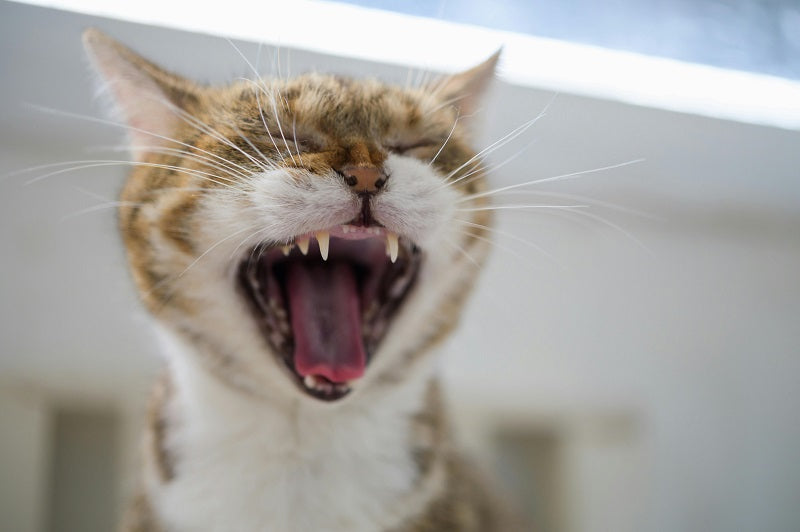In this Article
This expert guide gives a practical, low-stress routine to prevent plaque in cats. You’ll learn why plaque forms, how to brush efficiently, which adjuncts actually help, and how often to plan home care and vet checkups. The layout is single-column for clean insertion into Shopify sections.
Plaque is a living biofilm. Within hours after eating, bacteria colonize tooth surfaces; minerals then harden plaque into tartar, irritating gums and driving gingivitis. Unchecked inflammation can progress to periodontal disease, tooth loss, and pain that many cats hide. The fix isn’t force—it’s gentle consistency.
How prevention works (evidence-informed)
Effective prevention targets three points: (1) biofilm disruption (brushing, wipes), (2) chemical aid that weakens plaque matrix (enzymatic pastes/gels, certain water additives), and (3) mechanical abrasion via appropriately textured dental treats. Brushing remains the gold standard because bristles reach the gingival margin— the exact zone where disease starts. Enzymatic products help on days when brushing is brief, but they are adjuncts, not replacements.
Cats accept care better with desensitization: introduce taste first, then touch, then brief brushing. Aim for the outer surfaces of canines and premolars; most plaque accumulates there. Inner surfaces contribute less and can be skipped on sensitive cats without losing most of the benefit.
Daily routine (6 steps, ~5–7 minutes)
- Set the scene (30–60s): Choose a calm time. Offer a pea-sized lick of cat-safe enzymatic toothpaste (never human paste). Reward curiosity.
- Cheek lifts (30s): Lift the lip gently; touch a finger brush or ultra-soft cat toothbrush to the canine. Release. Treat.
- Micro-circles (1–2 min): Brush the outer gumline of canines and premolars in tiny circles. Keep pressure light—your goal is to disrupt biofilm, not scrub enamel.
- Breaks (30s): Pause often. End before your cat loses patience to build a positive history.
- Gel finisher (30–60s): Apply a thin line of enzymatic dental gel along the upper gums. It keeps working even if your brushing time was short.
- Adjunct (30s): Offer a small dental treat or use a measured water additive per label. Monitor calories and water intake.
Table — Daily & weekly routine at a glance
| Step | What to do | Tools | Frequency | Time |
|---|---|---|---|---|
| Brushing core | Micro-circles along outer gumline | Cat toothbrush / finger brush + enzymatic paste | Daily (ideal) or 3–4×/week minimum | 2–3 min |
| Gel support | Thin line on upper gums | Enzymatic dental gel | Daily, esp. on short-brush days | 30–60s |
| Dental wipes | Swipe outer teeth when you skip brushing | Textured wipes | As needed | 1–2 min |
| Water additive | Add to fresh water per label | Cat-specific additive | Daily (optional) | 10s |
| Dental treat | Crunchy, plaque-scoring shape | See treats guide | 3–5×/week (count calories) | 10–60s |
Beginner plan: brush one quadrant per day (UR/UL/LR/LL). After 7–10 days most cats tolerate full arches.
How often to do each item
- Brushing: Daily best; minimum 3–4×/week to materially reduce plaque.
- Gels / wipes: On days with shorter brushing or during training phases.
- Dental treats: 3–5×/week; split large pieces; subtract equivalent calories from meals.
- Water additives: Daily in fresh water if your cat drinks well and accepts the taste.
- Vet oral exam: Healthy adults annually; seniors (10+) or prior dental disease every 6 months.
- Professional cleaning: When exam + dental radiographs indicate tartar below the gumline or periodontal pockets.
Table — Vet follow-up cadence
| Cat profile | Clinic exam | Dental imaging | Cleaning expectation |
|---|---|---|---|
| Healthy adult (1–9y) | Every 12 months | As indicated by gingivitis/tartar | Every 1–2 years on average |
| Senior (10+) | Every 6 months | Baseline dental radiographs recommended | Every 1 year typical; sooner if pockets form |
| History of dental disease | Every 6 months | Imaging to monitor progression | As advised; some require 6–12 month intervals |
Illustrative chart — routine frequency vs relative plaque risk
The SVG chart below visualizes a practical reality: small, frequent care outperforms sporadic efforts. Scale is 0–100 (lower is better) and illustrates typical trends; individual outcomes vary by diet and genetics.
Use this to explain to owners why “a little every day” beats “a lot once in a while”.
Product roundup (neutral — no brands)
- Cat toothbrush: Ultra-soft bristles and a small head. Finger brushes are ideal for starters; a handled brush reaches premolars better once trained.
- Enzymatic toothpaste: Cat-safe flavors; enzymes break down plaque matrix. Never use human toothpaste (fluoride/foaming agents can be harmful).
- Dental gel: Apply a thin line to upper gums after brief brushing sessions. Helpful for cats with low tolerance.
- Dental wipes: Textured wipes to disrupt biofilm on skip days; not a full substitute for brushing.
- Water additive: Use as labeled; refresh water daily. Works best as part of a broader routine.
- Dental treats & crunchy kibble: Choose shapes that encourage chewing with mechanical abrasion. Keep portions small and factor calories into meals.
- Safe chew toys: Cat-sized, supervised use for enrichment and light abrasion.
Warning signs & when to see a vet
Dental pain in cats is often silent. Seek a veterinary exam if you observe any of the following.
| Sign | What it may indicate | Next step |
|---|---|---|
| Bad breath returning within days | Persistent plaque/gingivitis; possible periodontal pockets | Book an oral exam; consider professional cleaning |
| Red, swollen, or bleeding gums | Active gingivitis or stomatitis | Vet visit within 1–2 weeks; sooner if bleeding persists |
| Drooling, pawing at mouth, face sensitivity | Pain; possible tooth resorption or fracture | Prompt vet assessment; dental radiographs recommended |
| Prefers soft food, drops kibble | Oral pain or loose teeth | Vet exam; adjust diet temporarily if needed |
| Visible yellow/brown tartar near gumline | Mineralized plaque; likely subgingival involvement | Professional cleaning likely required |
Owner playbook — making it stick
- Anchor habit: Tie brushing to a daily event (after dinner). Cats thrive on predictable sequences.
- Use micro-sessions: Two 90-second sessions can outperform a single 3-minute session if cooperation is higher.
- Reinforce calm: Treats after cooperation, not after resistance. Finish on a win.
- Data helps: Note acceptance on a 1–5 scale for a week. Increase time once average ≥3.
- Diet context: Brushing matters regardless of wet vs dry food. Treat the diet debate as separate; plaque is about biofilm, not just texture.
- Multi-cat households: Train one cat at a time; keep tools labeled to avoid taste contamination.
- Sanitation: Rinse brushes, air-dry upright, replace every 2–3 months.
Mini-FAQ
Is a water additive enough by itself?
No. It can reduce bacterial load but doesn’t replace mechanical biofilm disruption at the gumline. Combine with brushing or wipes.
My cat hates brushes. What now?
Start with taste training (paste only) for 5–7 days, then touch teeth with a finger, then a finger brush, then a handled brush. Keep sessions under 60–90 seconds and end on a success.
How do I prevent excess calories from dental treats?
Use the smallest effective portion, split larger treats, and subtract equivalent calories from meals. Limit to 3–5 times per week.
When should seniors get imaging?
From ~10 years old, baseline dental radiographs help detect hidden resorptive lesions and guide cleaning frequency.

